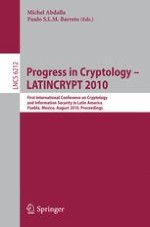2010 | Buch
Progress in Cryptology – LATINCRYPT 2010
First International Conference on Cryptology and Information Security in Latin America, Puebla, Mexico, August 8-11, 2010, proceedings
herausgegeben von: Michel Abdalla, Paulo S. L. M. Barreto
Verlag: Springer Berlin Heidelberg
Buchreihe : Lecture Notes in Computer Science
